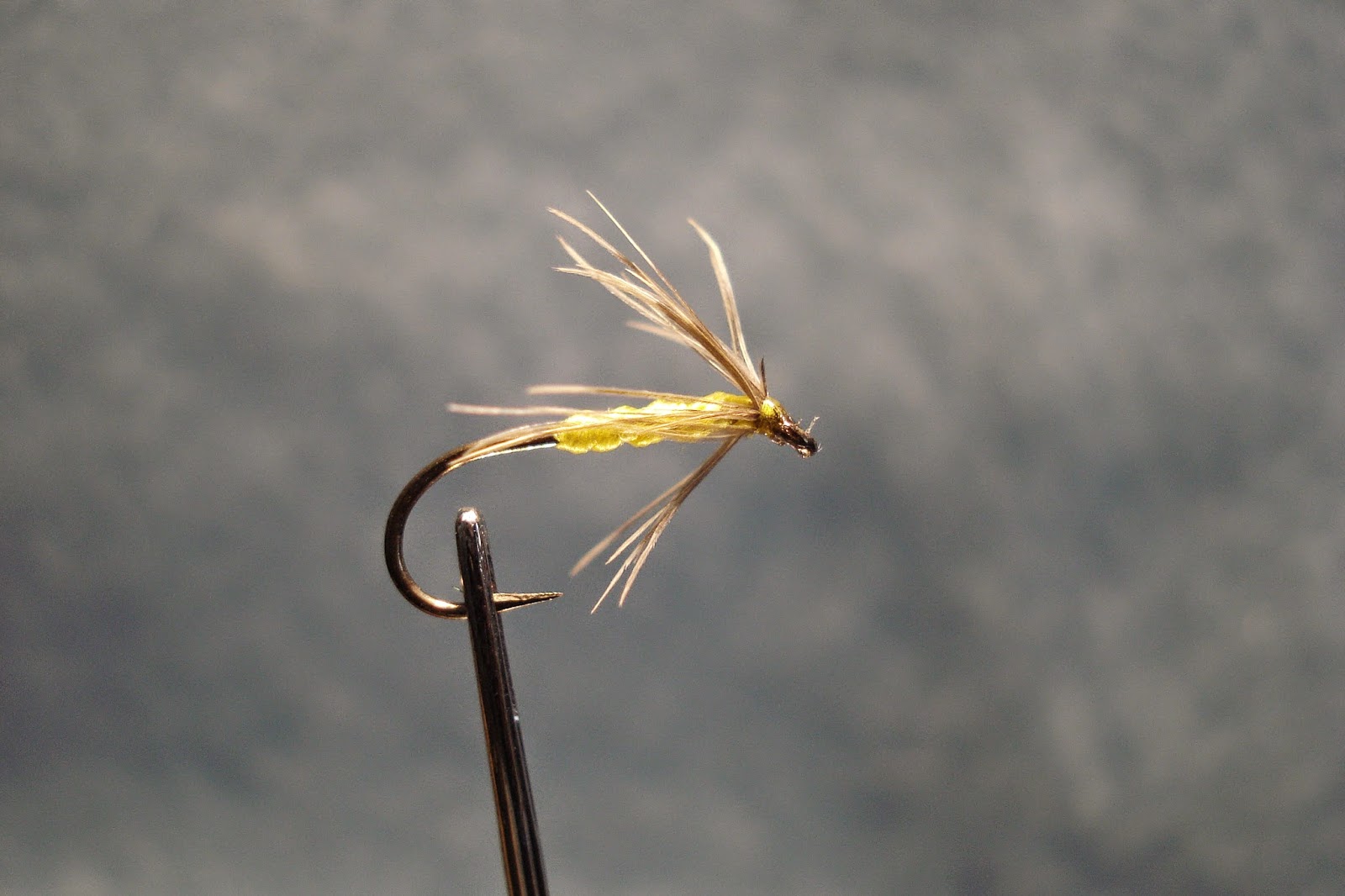 |
| This dressing of the orange Dotterel uses silk buttonhole twist - Talon 455 orange, size D, lightly twisted to suggest a natural rib. |
 |
| This dressing of the orange Dotterel uses silk buttonhole twist - Coats & Clark's lemon 223, size D, lightly twisted to suggest a natural rib. |
Hook:
|
12-16
|
|
Thread:
|
Orange or yellow to match the body
|
|
Body:
|
Orange or Yellow
|
|
Hackle:
|
Starling undercoverts, dun with light tan tips
|
|
The Dotterel is a standard North Country or
Scottish spider. In his Northern Angler
(1837), Scottish angler John Kirkbride calls it the “most destructive fly in
this part of the country, killing remarkably well during the whole season.”
Harfield Edmonds and Norman Lee regard it as most effective from May to
September in Brook and River Trouting
(1916). Likewise, in his North-Country
Flies (1886), T. E. Pritt explains that “the dotterel is a good standard
fly all through the season from the end of April, more especially on rather
cold days.” While he concedes that it “is undoubtedly a splendid killer,”
Pritt speculates “whether its reputation on all the Yorkshire, and other
north country rivers, is not in excess of its merits.”
Edmonds and Lee put forward the standard
dressing for the Dotterel as No. 17 in their book, elaborating slightly on
Pritt’s Dotterel, No. 35:
“WINGS.—Hackled with a
light-tipped fawnish feather from the marginal coverts or lesser coverts of a
Dotterel’s wing.
BODY.—Orange silk, No.
6, or primrose yellow silk, No. 3.
HEAD.—Orange silk, or
primrose yellow silk.”
Pritt suggests “Straw-coloured silk” for the
body, but he notes that “some anglers prefer Orange silk.” E. M. Tod’s
preference is evident in his name for the fly, the Dotterel and Orange, but
his dressing is identical. Michael Theakston offers a Dotterel Dun as the 79th
fly in his List of Natural Flies
(1843), dressing it with the a body of
“copper-colored silk, slightly tinged with water-rat’s fur; winged with a
dotterel’s feather; winged with slips and a few fibers of mohair or hare’s
ear, wrought in at the breast.” Only Kirkbride’s dressing varies wildly from
the simple spider. His fly has a hare’s ear body, dyed yellow, gradually
lightened as the season advances with addition of yellow mohair. In
discolored water, Kirkbride’s Dotterel has a three-part body: hare’s ear dyed
yellow in the front, a band of yellow thread in the middle, and a sparsely
dubbed muskrat section near the bend of the hook.
In light of its reputation, what might be most
significant about the Dotterel soft hackle is that it can no longer be
dressed authentically. Its namesake hackle comes from a long-protected
species. Leslie Magee discusses the challenge of dressing the Dotterel
without dotterel in Fly Fishing: the
North-Country Tradition (1996): “I have carefully examined several museum
skins of Dotterel and I must say that I believe that it would be extremely
difficult to differentiate between the feathers formerly used for the
‘Dotteril Fly’ and feathers selected from some other birds. I have also
examined Dotterel feathers in old fly wallets and it would seem that because
of the rarity of the bird, that a wide range of its feathers were made use
of.” Pritt suggests curlew.
In The
Art of Tying the Wet Fly and Fishing the Flymph (1941), James Leisenring
does not even include dotterel hackled under a separate heading as he does
for other land bird hackles like the coot, partridge, jackdaw, and snipe. The
dotterel is a footnote to the starling, which provides an a perfect
substitute that is “found among the undercoverts of the starling wing. The
feathers are dun colored with buff or yellow tips, and can be distinguished
from the genuine dotterel only by a difference in stiffness.” Edmonds and Lee
make a similar recommendation, as does W. C. Stewart in The Practical Angler (1857).
|
No comments:
Post a Comment
Note: Only a member of this blog may post a comment.